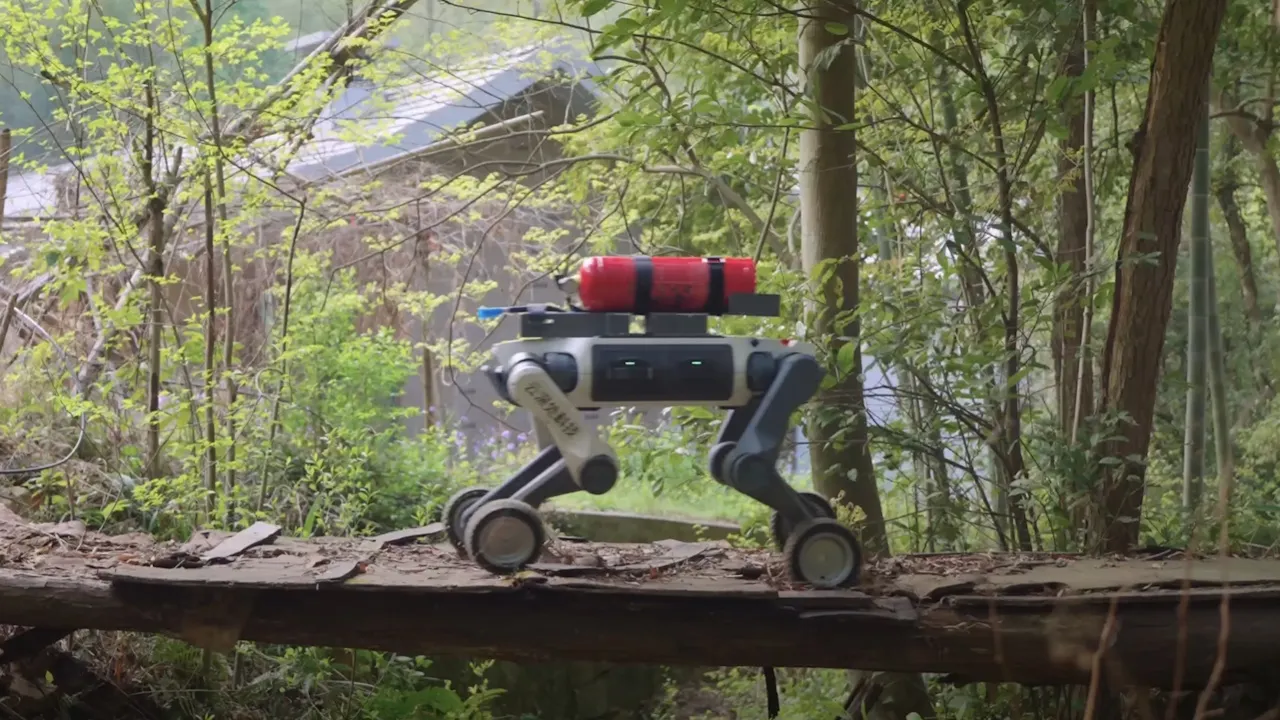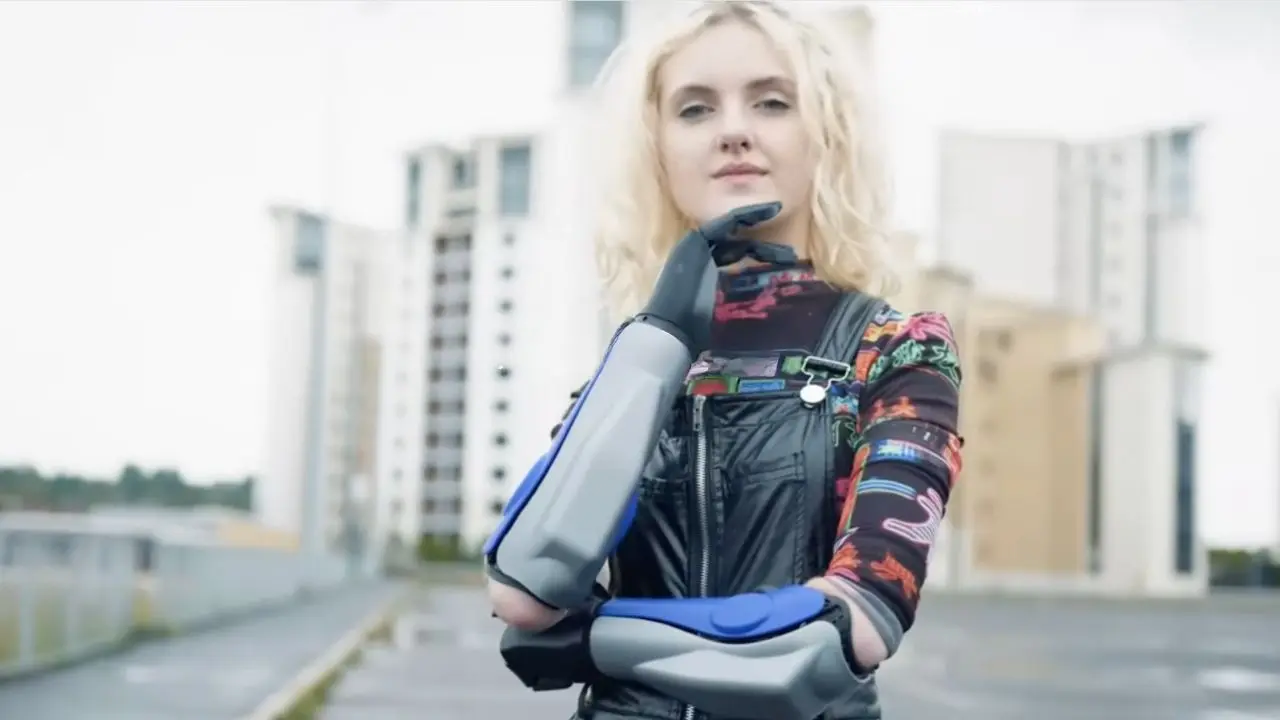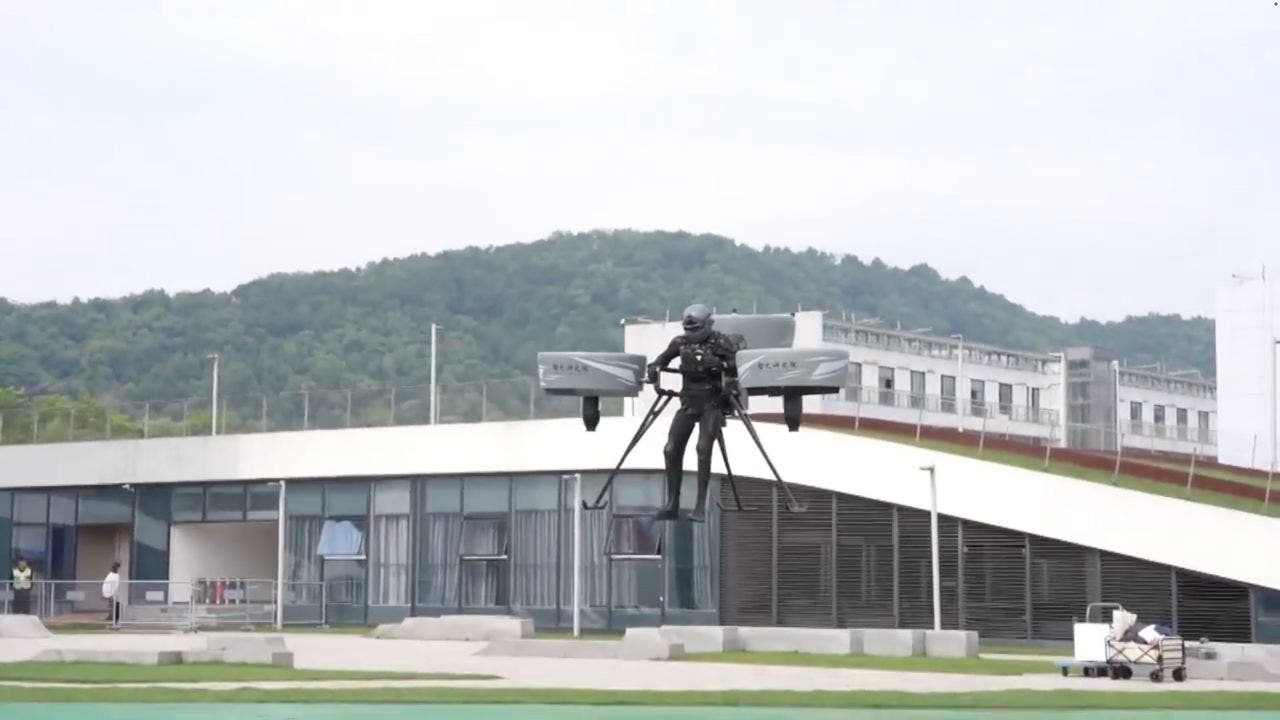AI to monitor NYC subway safety as crime concerns rise
















Many creative industries rely on cutting-edge digital technologies, so it is not surprising that this sector could easily become an early adopter of quantum computing.
In this episode of the Physics World Weekly podcast I am in conversation with James Wootton, who is chief scientific officer at Moth Quantum. Based in the UK and Switzerland, the company is developing quantum-software tools for the creative industries – focusing on artists, musicians and game developers.
Wootton joined Moth Quantum in September 2024 after working on quantum error correction at IBM. He also has long-standing interest in quantum gaming and creating tools that make quantum computing more accessible. If you enjoyed this interview with Wootton, check out this article that he wrote for Physics World in 2018: “Playing games with quantum computers“.
This article forms part of Physics World‘s contribution to the 2025 International Year of Quantum Science and Technology (IYQ), which aims to raise global awareness of quantum physics and its applications.
Stayed tuned to Physics World and our international partners throughout the next 12 months for more coverage of the IYQ.
Find out more on our quantum channel.
The post Quantum computing for artists, musicians and game designers appeared first on Physics World.
The UK-based company Delta.g has bagged the 2025 qBIG prize, which is awarded by the Institute of Physics (IOP). Initiated in 2023, qBIG celebrates and promotes the innovation and commercialization of quantum technologies in the UK and Ireland.
Based in Birmingham, Delta.g makes quantum sensors that measure the local gravity gradient. This is done using atom interferometry, whereby laser pulses are fired at a cloud of cold atoms that is freefalling under gravity.
On the Earth’s surface, this gradient is sensitive to the presence of buildings and underground voids such as tunnels. The technology was developed by physicists at the University of Birmingham and in 2022 they showed how it could be used to map out a tunnel below a road on campus. The system has also been deployed in a cave and on a ship to test its suitability for use in navigation.
“Gravity is a fundamental force, yet its full potential remains largely untapped because it is so challenging to measure,” explains Andrew Lamb who is co-founder and chief technology officer at Delta.g. “As the first to take quantum technology gravity gradiometry from the lab to the field, we have set a new benchmark for high-integrity, noise-resistant data transforming how we understand and navigate the subsurface.”
Awarded by the IOP, the qBIG prize is sponsored by Quantum Exponential, which is the UK’s first enterprise venture capital fund focused on quantum technology. The winner was announced today at the Economist’s Commercialising Quantum Global 2025 event in London. Delta.g receives a £10,000 unrestricted cash prize; 10 months of mentoring from Quantum Exponential; and business support from the IOP.
Louis Barson, the IOP’s director of science, innovation and skills says, “The IOP’s role as UK and Ireland coordinator of the International Year of Quantum 2025 gives us a unique opportunity to showcase the exciting developments in the quantum sector. Huge congratulations must go to the Delta.g team, whose incredible work stood out in a diverse and fast-moving field.”
Two runners-up were commended by the IOP. One is Glasgow-based Neuranics, which makes quantum sensors that detect tiny magnetic signals from the human body. This other is Southampton’s Smith Optical, which makes an augmented-reality display based on quantum technology.
This article forms part of Physics World‘s contribution to the 2025 International Year of Quantum Science and Technology (IYQ), which aims to raise global awareness of quantum physics and its applications.
Stayed tuned to Physics World and our international partners throughout the next 12 months for more coverage of the IYQ.
Find out more on our quantum channel.
The post Delta.g wins IOP’s qBIG prize for its gravity sensors appeared first on Physics World.
What does the word “overselling” mean to you? At one level, it can just mean selling more of something than already exists or can be delivered. It’s what happens when airlines overbook flights by selling more seats than physically exist on their planes. They assume a small fraction of passengers won’t turn up, which is fine – until you can’t fly because everyone else has rocked up ahead of you.
Overselling can also involve selling more of something than is strictly required. Also known as “upselling”, you might have experienced it when buying a car or taking out a new broadband contract. You end up paying for extras and add-ons that were offered but you didn’t really need or even want, which explains why you’ve got all those useless WiFi boosters lying around the house.
There’s also a third meaning of “overselling”, which is to exaggerate the merits of something. You see it when a pharmaceutical company claims its amazing anti-ageing product “will make you live 20 years longer”, which it won’t. Overselling in this instance means overstating a product’s capability or functionality. It’s pretending something is more mature than it is, or claiming a technology is real when it’s still at proof-of-concept-stage.
From my experience in science and technology, this form of overselling often happens when companies and their staff want to grab attention or to keep customers or consumers on board. Sometimes firms do it because they are genuinely enthusiastic (possibly too much so) about the future possibilities of their product. I’m not saying overselling is necessarily a bad thing but just that there are reservations.
Before I go any further, let’s learn the lingo of overselling. First off, there’s “vapourware”, which refers to a product that either doesn’t exist or doesn’t fulfil the stated technical capability. Often, it’s something a firm wants to include in its product portfolio because they’re sure people would like to own it. Deep down, though, the company knows the product simply isn’t possible, at least not right now. Like a vapour, it’s there but can’t be touched.
Sometimes vapourware is just a case of waiting for product development to catch up with a genuine product plan. Sales staff know they haven’t got the product at the right specification yet, and while the firm will definitely get there one day, they’re pretending the hurdles have already been crossed. But genuine over-enthusiasm can sometimes cross over into wishful thinking – the idea that a certain functionality can be achieved with an existing technical approach.
Do you remember Google Glass? This was wearable tech, integrated into spectacle frames, that was going to become the ubiquitous portable computer. Information would be requested via voice commands, with the user receiving back the results, visible on a small heads-up display. While the computing technology worked, the product didn’t succeed. Not only did it look clunky, there were also deployment constraints and concerns about privacy and safety.
Google Glass simply didn’t capture the public’s imagination or meet the needs of enough consumers
Google Glass failed on multiple levels and was discontinued in 2015, barely a year after it hit the market. Subsequent relaunches didn’t succeed either and the product was pulled for a final time in 2023. Despite Google’s best efforts, the product simply didn’t capture the public’s imagination or meet the needs of enough consumers.
Next up in our dictionary of overselling is “unobtanium”, which is a material or material specification that we would like to exist, but simply doesn’t. In the aerospace sector, where I work, we often dream of unobtanium. We’re always looking for materials that can repeatedly withstand the operational extremes encountered during a flight, while also being sustainable without cutting corners on safety.
Like other engine manufacturers, my company – GE Aerospace – is pioneering multiple approaches to help develop such materials. We know that engines become more efficient when they burn at higher temperatures and pressures. We also know that nitrous-oxide (NOx) emissions fall when an engine burns more leanly. Unfortunately, there are no metals we know of that can survive to such high temperatures.
But the quest for unobtanium can drive innovative technical solutions. At GE, for example, we’re making progress by looking instead at composite materials, such as carbon fibre and composite matrix ceramics. Stronger and more tolerant to heat and pressure than metals, they’ve already been included on the turbofan engines in planes such as the Boeing 787 Dreamliner.
We’re also using “additive manufacturing” to build components layer by layer. This approach lets us make highly intricate components with far less waste than conventional techniques, in which a block of material is machined away. We’re also developing innovative lean-burn combustion technologies, such as novel cooling and flow strategies, to reduce NOx emissions.
While unobtanium can never be reached, it’s worth trying to get there to drive technology forward
A further example is the single crystal turbine blade developed by Rolls-Royce in 2012. Each blade is cast to form a single crystal of super alloy, making it extremely strong and able to resist the intense heat inside a jet engine. According to the company, the single crystal turbine blades operate up to 200 degrees above the melting point of their alloy. So while unobtanium can never be reached, it’s worth trying to get there to drive technology forward.
Now, here’s the caveat. There’s an unwelcome side to overselling, which is that it can easily morph into downright mis-selling. This was amply demonstrated by the Volkswagen diesel emissions scandal, which saw the German carmaker install “defeat devices” in its diesel engines. The software changed how the engine performed when it was undergoing emissions tests to make its NOx emissions levels appear much lower than they really were.
VW was essentially falsifying its diesel engine emissions to conform with international standards. After regulators worldwide began investigating the company, VW took a huge reputational and financial hit, ultimately costing it more than $33bn in fines, penalties and financial settlements. Senior chiefs at the company got the sack and the company’s reputation took a serious hit.
It’s tempting – and sometimes even fun – to oversell. Stretching the truth draws interest from customers and consumers. But when your product no longer does “what it says on the tin”, your brand can suffer, probably more so than having something slightly less functional.
On the upside, the quest for unobtanium and, to some extent, the selling of vapourware can drive technical progress and lead to better technical solutions. I suspect this was the case for Google Glass. The underlying technology has had some success in certain niche applications such as medical surgery and manufacturing. So even though Google Glass didn’t succeed, it did create a gap for other vendors to fill.
Google Glass was essentially a portable technology with similar functionality to smartphones, such as wireless Internet access and GPS connectivity. Customers, however, proved to be happier carrying this kind of technology in their hands than wearing it on their heads. The smartphone took off; Google Glass didn’t. But the underlying tech – touchpads, cameras, displays, processors and so on – got diverted into other products.
Vapourware, in other words, can give a firm a competitive edge while it waits for its product to mature. Who knows, maybe one day even Google Glass will make a comeback?
The post Vapourware and unobtanium: why overselling is not (always) a good idea appeared first on Physics World.
Vaire Computing is a start-up seeking to commercialize computer chips based on the principles of reversible computing – a topic Earley studied during her PhD in applied mathematics and theoretical physics at the University of Cambridge, UK. The central idea behind reversible computing is that reversible operations use much less energy, and thus generate much less waste heat, than those in conventional computers.
In an early-stage start-up environment, you have to wear lots of different hats. Right now, I’m planning for the next few years, but I’m also very deep into the engineering side of Vaire, which spans a lot of different areas.
The skill I use most is my ability to jump into a new field and get up to speed with it as quickly as possible, because I cannot claim to be an expert in all the different areas we work in. I cannot be an expert in integrated circuit design as well as developing electronic design automation tooling as well as building better resonators. But what I can do is try to learn about all these things at as deep a level as I can, very quickly, and then guide the people around me with higher-level decisions while also having a bit of fun and actually doing some engineering work.
We have so many great people at Vaire, and being able to talk with them and discuss all the most interesting aspects of their specialities is probably the part I like best. But I’m also enjoying the fact that in a few years, all this work will culminate in an actual product based on things I worked on when I was in academia. I love theory, and I love thinking about what could be possible in hundreds of years’ time, but seeing an idea get closer and closer to reality is great.
The part I have more of a love-hate relationship with is just how intense this job is. I’m probably intrinsically a workaholic. I don’t think I’ve ever had a good balance in terms of how much time I spend on work, whether now or when I was doing my PhD or even before. But when you are responsible for making your company succeed, that degree of intensity becomes unavoidable. It feels difficult to take breaks or to feel comfortable taking breaks, but I hope that as our company grows and gets more structured, that part will improve.
There are so many specifics of what it means to build a computer chip that I wish I’d known. I may even have suffered a little bit from the Dunning–Kruger effect [in which people with limited experience of a particular topic overestimate their knowledge] at the beginning, thinking, “I know what a transistor is like. How hard can it be to build a large-scale integrated circuit?”
It turns out it’s very, very hard, and there’s a lot of complexity around it. When I was a PhD student, it felt like there wasn’t that big a gap between theory and implementation. But there is, and while to some extent it’s not possible to know about something until you’ve done it, I wish I’d known a lot more about chip design a few years ago.
The post Ask me anything: Hannah Earley – ‘I love theory, but seeing an idea get closer and closer to reality is great’ appeared first on Physics World.
This episode of the Physics World Weekly podcast features the materials scientist Paul Meredith, who is director of the Centre for Integrative Semiconductor Materials (CISM) at the UK’s Swansea University.
In a conversation with Physics World’s Matin Durrani, Meredith talks about the importance of semiconductors in a hi-tech economy and why it is crucial for the UK to have a homegrown semiconductor industry.
Founded in 2020, CISM moved into a new, state-of-the-art £50m building in 2023 and is now in its first full year of operation. Meredith explains how technological innovation and skills training at CSIM is supporting chipmakers in the M4 hi-tech corridor, which begins in Swansea in South Wales and stretches eastward to London.
The post Driving skills and innovation in the UK’s semiconductor industry appeared first on Physics World.
I recently met an old friend from the time when we both worked in the light-emitting diode (LED) industry. We started discussing how every technology has its day – a window of opportunity – but also how hard it is to know which companies will succeed long-term. As we got talking, I was reminded of a very painful product launch by an LED lighting firm that I was running at the time.
The incident occurred in 2014 when my company had a technology division that was developing wirelessly connected lighting. Our plan was to unveil our new Bluetooth control system at a trade show, but everything that could go wrong for us on the day pretty much did. However, the problems with our product weren’t down to any
particular flaws in our technology.
Instead, they were triggered by issues with a technology from a rival lighting firm that was also exhibiting at the event. We ended up in a rather ugly confrontation with our competitors, who seemed in denial about their difficulties. I realized there was a fundamental problem with their technology – even if they couldn’t see it – and predicted that, for them, the writing was on the wall.
Our plan was to put microprocessors and radios into lighting to make it smart, more energy efficient and with integrated sensors and Bluetooth controls. There were no fundamental physics barriers – it just needed some simple thermal management (the LEDs and particularly the radios had to be kept below 70 ºC), some electronics and lots of software.
Back then, the LED lighting industry was following a technology roadmap that envisaged these solid-state devices eventually generating 320 lumens per watt, compared to about 10 lumens per watt from conventional incandescent lamps. As the road map progressed, there’d be ever fewer thermal challenges.
With more and more countries phasing out conventional bulbs, LEDs are continuing their march along the roadmap. Almost every bulb sold these days is an LED and the overall global lighting market was worth $140bn in 2023, according to Fortune Business Insights. Lighting accounts for 15–18% of all electricity consumption in the European Union alone.
Back at that 2014 trade show, called LuxLive, all initially seemed to be going well as we set up our display. There was the odd software bug, but were able to work around that and happily control our LED lights with a smart phone connected via WiFi to a low-cost lighting server (a bit like a Raspberry Pi), with the smart LED fixtures and sensors connected via Bluetooth.

With final preparations over, the trade show opened and our first customer came up to the stand. We started giving them a demo but nothing seemed to be working – to our surprise, we simply could not get our lights to respond. A flurry of behind-the-scenes activity ensured (mostly us switching everything off and on again) but nothing made a difference.
Strangely, my phone call appeared to go dead just as I passed another booth from a rival firm
To try to get to the bottom of things, I stepped a decent distance away from our booth and rang one of our technical team up in London for support. I explained our problem but, strangely, as I walked back towards the booth, I got cut off. My call appeared to have gone dead just as I passed another booth from a rival firm called Ceravision.
It was developing high-efficiency plasma (HEP) lamps that could generate up to 100 lumens per watt – roughly where LEDs were at the time. Its lamps used radio-frequency waves to heat a plasma without needing any electrodes. Designed for sports stadia and warehouses, Ceravision’s bulbs were super bright. In fact, I was almost blinded by its products, which were pointing into the aisle, presumably to attract attention.
Back at base, our technical team frantically tried to figure out why our products weren’t working. But they were stuck and I spent the rest of the day unable to demonstrate our products to potential customers. Then, as if by magic, our system started working again – just as someone noticed we weren’t being blinded by Ceravision’s light any more.
I walked over to Ceravision’s booth as its team was packing up and had a chat with a sales guy, who I asked how the system worked. He told me it was a microwave waveguide light source but didn’t appear to know much more. So I asked him if he wouldn’t mind turning on the light again to demonstrate its output, which he did.
I glanced back at my team, who a few moments earlier had been all smiles that our system was now working, even if they were confused as to why. Suddenly, as the Ceravision light was turned on, our system broke down again. I requested to speak to one of Ceravision’s technical team but was told they wouldn’t be back until the following day.
I left for the show’s awards dinner, where my firm won an innovation award for the wireless lighting system we’d been trying – unsuccessfully – to demonstrate all day. Later that night, I started looking into Ceravision in more detail. Based in Milton Keynes, UK, its idea of an electrodeless lamp wasn’t new – Nikola Tesla had filed a patent for such a device back in 1894.
Tesla realized that this type of lamp would benefit from a long life and little discolouration as there are no electrodes to degrade or break. In fact, Tesla knew how to get around the bulbs’ technical drawbacks, which involved constraining the radio waves and minimizing their power. Eventually, in the late 1990s, as radio-frequency sources became available, a US company called Fusion Lighting got this technology to market.
Its lamps consisted of a golf ball-sized fused-quartz bulb containing several milligrams of sulphur powder and argon gas at the end of a thin glass spindle. Enclosed in a microwave-resonant wire-mesh cage, the bulb was bombarded by 2.45 GHz microwaves from a magnetron of the kind you get in a microwave oven. The bulb had a design lifetime of about 60,000 hours and emitted 100 lumens per watt.
Unfortunately, its efficiency was poor as 80–85% of the light generated was trapped inside the opaque ceramic waveguide. Worse still, various satellite companies petitioned the US authorities to force Fusion Lighting to cut its electromagnetic emissions by 99.9%. They feared that otherwise its bulbs would interfere with WiFi, cordless phones and satellite radio services in North America, which also operate at 2.4 GHz.

In 2001 Fusion Lighting agreed to install a perforated metal shield around its lamps to reduce electromagnetic emissions by 95%. However, this decision only reduced the light output, making the bulbs even more inefficient. Ceravision’s solution was an optically clear quartz waveguide and integrated lamp that yielded 100–5000 watts of power without any damage to the lamps.
The company claimed its technology was ideal for growing plants – delivering blue and ultraviolet light missing from other sources – along with everything from sterilizing water to illuminating TV studios. And whereas most magnetrons break down after about 2000 hours, Ceravision’s magnetrons lasted for more than 40,000 hours. It had even signed an agreement with Toshiba to build high-efficient magnetrons.
What could possibly go wrong?
Back at the trade show, I arrived the following morning determined to get a resolution with the Ceravision technical team. Casually, I asked one of them, who had turned up early, to come over to our booth to see our system. It was working – until the rest of Ceravision arrived and switched their lights on. Once again, our award-winning system gave up the ghost.
Ceravision refused to accept there was a correlation between their lights going on and our system breaking down
Things then got a little ugly. Ceravision staff refused to accept there was a correlation between their lights going on and our system breaking down. Our product must be rubbish, they said. If so, I asked, how come my mobile phone had stopped working too? Silence. I went to talk to the show organizers – all they could do was tell Ceravision to point its lights down, rather than into the aisle.
This actually worked for us as it seemed the “blocking signal” was reasonably directional. It became obvious from Ceravision’s defensive response that this WiFi blocking problem must have come up before – its staff had some over-elaborate and clearly rehearsed responses. As for us, we simply couldn’t show our product in its best light to customers, who just felt it wasn’t ready for market.

In the intervening years, I’ve talked to several ex-employees of Ceravision, who’ve all told me it trialled lots of different systems for different markets. But its products always proved to be too expensive and too complex – and eventually LEDs caught up with them. When I asked them about lights disrupting WiFi, most either didn’t seem aware of the issue or, if they did, knew it couldn’t be fixed without slashing the light output and efficiency of the bulbs.
That in turn forced Ceravision to look for ever more niche applications with ever-tinier markets. Many staff left, realizing the emperor had no clothes. Eventually, market forces took their toll on the company, which put its lighting business into receivership in 2020. Its parent company with all the patents and intellectual property suffered a similar fate in 2023.
I suspect (but don’t know for sure) that the window of opportunity closed due to high system costs, overly complex manufacturing and low volumes, coupled with LEDs becoming cheaper and more efficient. Looking back on 2014, the writing was really on the wall for the technology, even if no-one wanted to read the warning signs. A product that disrupts your mobile or WiFi signal was simply never going to succeed.
It was a classic case of a company having a small window of opportunity before better solutions came along and it missed the proverbial boat. Of course, hindsight is a wonderful thing. Clearly the staff could see what was wrong, but it took a long time for managers and investors to see or tackle the issues too. Perhaps when you are trying to deliver on promises you end up focusing on the wrong things.
The moral of the story is straightforward: constantly review your customers’ feedback and re-evaluate your products as the market develops. In business, it really is that simple if you want to succeed.
The post James McKenzie: how I knew the writing was on the wall for our rival’s lighting technology appeared first on Physics World.
 Nous avons déjà publié à plusieurs mains une synthèse de nos découvertes et de nos étonnements sur le dernier Laval Virtual. Nous vous proposons dans cette vidéo de revenir sur ...
Nous avons déjà publié à plusieurs mains une synthèse de nos découvertes et de nos étonnements sur le dernier Laval Virtual. Nous vous proposons dans cette vidéo de revenir sur ...
L’article Laval Virtual 2024 : la discussion ! est apparu en premier sur Réalité Augmentée - Augmented Reality.
 Comme chaque année après le CES, la “National Retail Federation” (NRF) a organisé son Retail’s Big Show 2024 du 14 au 16 janvier à Ney York. Avec l’ambition d’être le ...
Comme chaque année après le CES, la “National Retail Federation” (NRF) a organisé son Retail’s Big Show 2024 du 14 au 16 janvier à Ney York. Avec l’ambition d’être le ...
L’article Edition 2024 NRF / Big Show : La RA et le retail avec Thibault Mathieu de Wilkins Avenue AR est apparu en premier sur Réalité Augmentée - Augmented Reality.
 C’est avec un grand plaisir que nous vous proposons un résumé 100% subjectif de Laval Virtual 2023 par Grégory Maubon et Valerie Riffaud Cangelosi. Nous vous y parlons des conférences, ...
C’est avec un grand plaisir que nous vous proposons un résumé 100% subjectif de Laval Virtual 2023 par Grégory Maubon et Valerie Riffaud Cangelosi. Nous vous y parlons des conférences, ...
L’article Laval Virtual 2023 : la confirmation, l’innovation et l’émotion est apparu en premier sur Réalité Augmentée - Augmented Reality.
 C’est avec beaucoup de bonheur que nous serons présents sur le salon Museum Connections les 30 et 31 mars pour découvrir les nouveaux usages des technologies immersives dans le vaste ...
C’est avec beaucoup de bonheur que nous serons présents sur le salon Museum Connections les 30 et 31 mars pour découvrir les nouveaux usages des technologies immersives dans le vaste ...
L’article De la réalité augmentée à Museum Connections ? Of course, et RA’pro vous y propose une rencontre ! est apparu en premier sur Réalité Augmentée - Augmented Reality.
 Nous serons présents avec un grand Plaisir sur le salon Virtuality qui se déroule les 17 et 18 mars au Carreau du Temple, Paris. Ce sera l’occasion de rencontrer les ...
Nous serons présents avec un grand Plaisir sur le salon Virtuality qui se déroule les 17 et 18 mars au Carreau du Temple, Paris. Ce sera l’occasion de rencontrer les ...
L’article L’association RA’pro sera présente au salon Virtuality (17 et 18 mars à Paris) est apparu en premier sur Réalité Augmentée - Augmented Reality.
 Un équipementier aéronautique de rang 1 recherche un profil innovation rattaché au directeur engineering et product support. Le poste n’est pas figé mais les caractéristiques suivantes ont émergé : Quelques ...
Un équipementier aéronautique de rang 1 recherche un profil innovation rattaché au directeur engineering et product support. Le poste n’est pas figé mais les caractéristiques suivantes ont émergé : Quelques ...
L’article [job] Recherche profil innovation dans l’aéronautique est apparu en premier sur Réalité Augmentée - Augmented Reality.
 Article rédigé avec Jean-François Kitchiguine! Parce oui, pour WordPress, il n’y a qu’un auteur possible 🙂 Après la vision transverse du dernier Laval Virtual que nous avons décrite la semaine ...
Article rédigé avec Jean-François Kitchiguine! Parce oui, pour WordPress, il n’y a qu’un auteur possible 🙂 Après la vision transverse du dernier Laval Virtual que nous avons décrite la semaine ...
L’article Laval Virtual 2019, ce que nous avons retenu (2/2) est apparu en premier sur Réalité Augmentée - Augmented Reality.
 C'est avec un grand plaisir que nous sommes partenaires cette année de la première édition de Vivatechnology, qui se déroulera du 30 juin au 2 juillet à Paris. Nous vous proposons donc d'être nos invités sur le salon, en tant que visiteurs ou même en tant qu'exposants ! Lisez la suite :)
C'est avec un grand plaisir que nous sommes partenaires cette année de la première édition de Vivatechnology, qui se déroulera du 30 juin au 2 juillet à Paris. Nous vous proposons donc d'être nos invités sur le salon, en tant que visiteurs ou même en tant qu'exposants ! Lisez la suite :)
L’article Entreprises de la réalité augmentée, participez à Vivatechnology (avec RA’pro!) est apparu en premier sur Réalité Augmentée - Augmented Reality.
 Il nous a fallu un peu de temps pour compiler toutes nos sources d’informations et vous proposer une vision de la réalité augmentée au Consumer Electronics Show 2015 de Las Vegas. Pas mal de matériels présentés, peu d’innovations bluffantes et pas beaucoup d’usages clairs … Un résumé un peu rude mais qui semble confirmer ma vision “2014, une année de maturité pour la réalité augmentée”.
Il nous a fallu un peu de temps pour compiler toutes nos sources d’informations et vous proposer une vision de la réalité augmentée au Consumer Electronics Show 2015 de Las Vegas. Pas mal de matériels présentés, peu d’innovations bluffantes et pas beaucoup d’usages clairs … Un résumé un peu rude mais qui semble confirmer ma vision “2014, une année de maturité pour la réalité augmentée”.
L’article La réalité augmentée au CES 2015 est apparu en premier sur Réalité Augmentée - Augmented Reality.
A few months ago, I attended a presentation and reception at the Houses of Parliament in London for companies that had won Business Awards from the Institute of Physics in 2024. What excited me most at the event was hearing about the smaller start-up companies and their innovations. They are developing everything from metamaterials for sound proofing to instruments that can non-invasively measure pressure in the human brain.
The event also reminded me of my own experience working in the small-business sector. After completing my PhD in high-speed aerodynamics at the University of Southampton, I spent a short spell working for what was then the Defence and Evaluation Research Agency (DERA) in Farnborough. But wanting to stay in Southampton, I decided working permanently at DERA wasn’t right for me so started looking for a suitable role closer to home.
I soon found myself working as a development engineer at a small engineering company called Stewart Hughes Limited. It was founded in 1980 by Ron Stewart and Tony Hughes, who had been researchers at the Institute of Sound and Vibration Research (ISVR) at Southampton University. Through numerous research contracts, the pair had spent almost a decade developing techniques for monitoring the condition of mechanical machinery from their vibrations.
By attaching accelerometers or vibration sensors to the machines, they discovered that the resulting signals can be processed to determine the physical condition of the devices. Their particular innovation was to find a way to both capture and process the accelerometer signals in near real time to produce indicators relating to the health of the equipment being monitored. It required a combination of hardware and software that was cutting edge at the time.
Although I did not join the firm until early 1994, it still had all the feel of a start-up. We were located in a single office building (in reality it was a repurposed warehouse) with 50 or so staff, about 40 of whom were electronics, software and mechanical engineers. There was a strong emphasis on “systems engineering” – in other words, integrating different disciplines to design and build an overarching solution to a problem.
In its early years, Stewart Hughes had developed a variety of applications for their vibration health monitoring technique. It was used in all sorts of areas, ranging from conveyor belts carrying coal and Royal Navy ships travelling at sea to supersized trucks working on mines. But when I joined, the company was focused on helicopter drivetrains.
In particular, the company had developed a product called Health and Usage Monitoring System (HUMS). The UK’s Civil Aviation Authority required this kind of device to be fitted on all helicopters transporting passengers to and from oil platforms in the North Sea to improve operational safety. Our equipment (and that of rival suppliers – we did not have a monopoly) was used to monitor mechanical parts such as gears, bearings, shafts and rotors.
For someone straight out of university, it was an exciting time. There were lots of technical challenges to be solved, including designing effective ways to process signals in noisy environments and extracting information about critical drivetrain components. We then had to convert the data into indicators that could be monitored to detect and diagnose mechanical issues.
As a physicist, I found myself working closely with the engineers but tended to approach things from a more fundamental angle, helping to explain why certain approaches worked and others didn’t. Don’t forget that the technology developed by Stewart Hughes wasn’t used in the comfort of a physics lab but on a real-life working helicopter. That meant capturing and processing data on the airborne helicopter itself using bespoke electronics to manage high onboard data rates.
After the data were downloaded, they had to be sent on floppy disks or other portable storage devices to ground stations. There the results would be presented in a form to allow customers and our own staff to interpret and diagnose any mechanical problems. We also had to develop ways to monitor an entire fleet of helicopters, continuously learning and developing from experience.
Stewart Hughes’s innovative and successful HUMS technology, which was the first of its kind to be flown on a North Sea helicopter, saw the company win Queen’s Awards on two separate occasions. The first was in 1993 for “export achievement” and the second was in 1998 for “technological achievement”. By the end of 1998 the company was bought by Smiths Industries, which in turn was acquired by General Electric in 2007.
If it all sounds as if working in a small business is plain sailing, well it rarely is. A few years before I joined, Stewart Hughes had ridden out at least one major storm when it was forced to significantly reduce the workforce because anticipated contracts did not materialize. “Black Friday”, as it became known, made the board of directors nervous about taking on additional employees, often relying on existing staff to work overtime instead.
This arrangement actually suited many of the early-career employees, who were keen to quickly expand their work experience and their pay packet. But when I arrived, we were once again up against cash-flow challenges, which is the bane of any small business. Back then there were no digital electronic documents and web portals, which led to some hairy situations.
I can recall several occasions when the company had to book a despatch rider for 2 p.m. on a Friday afternoon to dash a report up the motorway to the Ministry of Defence in London. If we hadn’t got an approval signature and contractual payment before the close of business on the same day, the company literally wouldn’t have been able to open its doors on Monday morning.
Being part of a small company was undoubtedly a formative part of my early career experience
At some stage, however, the company’s bank lost patience with this hand-to-mouth existence and the board of directors was told to put the firm on a more solid financial footing. This edict led to the company structure becoming more formal and the directors being less accessible, with a seasoned professional brought in to help run the business. The resulting change in strategic trajectory eventually led to its sale.
Being part of a small company was undoubtedly a formative part of my early career experience. It was an exciting time and the fact all employees were – literally – under one roof meant that we knew and worked with the decision makers. We always had the opportunity to speak up and influence the future. We got to work on unexpected new projects because there was external funding available. We could be flexible when it came to trying out new software or hardware as part of our product development.
The flip side was that we sometimes had to flex too much, which at times made it hard to stick to a cohesive strategy. We struggled to find cash to try out blue sky or speculative approaches – although there were plenty of good ideas. These advantages come with being part of a larger corporation with bigger budgets and greater overall stability.
That said, I appreciate the diverse and dynamic learning curve I experienced at Stewart Hughes. The founders were innovators, whose vision and products have stood the test of time, still being widely used today . The company benefited many people not just the staff who led successful careers but also the pilots and passengers on helicopters whose lives may potentially have been saved.
Working in a large corporation is undoubtedly a smoother ride than in a small business. But it’s rarely seat-of-the-pants stuff and I learned so much from my own days at Stewart Hughes. Attending the IOP’s business awards reminded me of the buzz of being in a small firm. It might not be to everyone’s taste, but if you get the chance to work in that environment, do give it serious thought.
The post Why nothing beats the buzz of being in a small hi-tech business appeared first on Physics World.
 Au sein de notre Lab de Sèvres , vous serez accompagné(e) par un Pilote Innovation (Chef de projet) pour vous permettre de développer vos compétences sur les activités d’un des ...
Au sein de notre Lab de Sèvres , vous serez accompagné(e) par un Pilote Innovation (Chef de projet) pour vous permettre de développer vos compétences sur les activités d’un des ...
L’article [Stage] Innovation : Ingénieur Réalité Étendue – Alten – Sèvres est apparu en premier sur Réalité Augmentée - Augmented Reality.
 Le projet a pour vocation de sauvegarder la biodiversité et plus précisément des oiseaux aux alentours des éoliennes. Il utilise une ou plusieurs caméras au sein d’un parc d’éoliennes pour ...
Le projet a pour vocation de sauvegarder la biodiversité et plus précisément des oiseaux aux alentours des éoliennes. Il utilise une ou plusieurs caméras au sein d’un parc d’éoliennes pour ...
L’article [Stage] Innovation : Ingénieur Réalité Etendue – ALTEN – Grenoble est apparu en premier sur Réalité Augmentée - Augmented Reality.